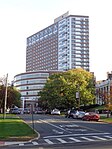Geology Hall, New Brunswick, New Jersey

Geology Hall, formerly Geological Hall, also known as the Rutgers Geology Museum, is a building located in the historic Queens Campus section of Rutgers, The State University of New Jersey's College Avenue Campus in New Brunswick, New Jersey, United States. When Rutgers was selected as New Jersey's only land grant college in 1864, the college began to expand its curriculum to include instruction in science and agriculture. Rutgers president William Henry Campbell raised funds to construct a building to accommodate this expansion, and Geology Hall, designed by architect Henry Janeway Hardenbergh, was built in 1872. As part of the Queen's Campus historic district, Geology Hall was included on the New Jersey Register of Historic Places and the National Register of Historic Places in 1973. At present, the building houses administrative offices and the university's geological museum. The museum, the oldest collegiate geology museum in the United States, was founded by state geologist and Rutgers professor George Hammell Cook in 1872. Its exhibits showcase the natural history of New Jersey; focusing geology, paleontology, and anthropology. Exhibits include fluorescent zinc minerals from Franklin and Ogdensburg, a mastodon from Salem County, a dinosaur trackway discovered in Towaco, and a Ptolemaic era Egyptian mummy.
Excerpt from the Wikipedia article Geology Hall, New Brunswick, New Jersey (License: CC BY-SA 3.0, Authors, Images).Geology Hall, New Brunswick, New Jersey
Sicard Street, New Brunswick
Geographical coordinates (GPS) Address Website Nearby Places Show on map
Geographical coordinates (GPS)
| Latitude | Longitude |
|---|---|
| N 40.498611111111 ° | E -74.4465 ° |
Address
Rutgers College Avenue Campus
Sicard Street
08901 New Brunswick
New Jersey, United States
Open on Google Maps









